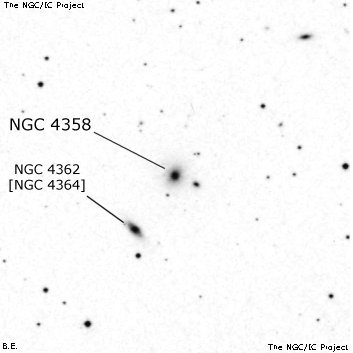NGC/IC Project Restoration Effort
(This is a very very beta version)
NGC4358


Basic Information
Location and Magnitude
Right Ascension: 12:24:2.1
Declination: +58:23:7
Constellation: UMA
Visual Magnitude: 13.2
Historic Information
Discoverer: Herschel W.
Year of discovery: 1789
Discovery aperture: 18.7
Observational
Summary description: cF, cS, lE
Sub-type: S0
Corwin's Notes
=====
NGC 4358, and NGC 4362 = NGC 4364. All three numbers are credited to WH, who
recorded them as follows on 17 April 1789:
WH delta RA delta Dec Star Desc
III 799 1m 12s p 1d 36m n 71 UMa vF, vS
III 800 1m 09s p 1d 37m n 71 UMa }
} Two, both cF, cS, R.
III 801 " " " " }
The "lE" notation in NGC comes from John Herschel, who observed only two of
these on 1 May 1831:
JH WH RA (1830) NPD Desc
1230 III 799 12 15 42.1 30 40 32 F, lE, the p of 2
1233 III 800 12 15 50.1 30 41 32 eF, the last of 2 (the
other was III 799;
III 801 not seen).
Note the relative positions, "p of 2" and "last of 2." These notes about
the positions should take precedence over any comments about shape since
apparent axis ratios depend on the limiting isophote of a galaxy (the deeper
the isophote, the rounder a galaxy appears).
This is how matters stood when JH put together the GC. There he assigned
three numbers (GC 2914, 18, 20) assuming that all three objects existed, and
added a comment about the RA of the first possibly being a minute later than
listed. I've not been able to track the source of this comment, as all the
positions measured up to that time are pretty much in agreement.
The other pre-NGC observation was by d'Arrest, who also saw only two objects
here (on 4 Oct 1866):
h H RA (1860) Dec
1230 III 799 12 17 28.1 +59 09 38
1233 III 800 12 17 32.1 +59 08 02
d'Arrest's descriptions and comments are all in Latin which I don't read. I
can make out the comment "III 800 is south-following" in the description for
III 799, and there is a four-line note about III 801 in the description for
III 800 (which also mentions the star just to the south).
Unfortunately, Lord Rosse and his observers did not look at these galaxies.
Based on JH's work on the GC, Dreyer again assigned three numbers. Later
(WH's Scientific Papers, and MN 73, 37, 1912), he noted: "Very probably the
word `two' refers to III 799 and III 800, as nobody seems to have seen three
nebulae in the place."
Both Bigourdan and Reinmuth also only saw two of the three -- though Bigourdan
claimed to have missed N4362 while Reinmuth could not find N4364 -- so that
has added to the confusion.
As Glen (Deen) noted, there are indeed three galaxies here; all are mentioned
in CGCG (only two entries, but the north-preceding is a pair), MCG (all
three), and UGC (the brightest is UGC 7479; the other two are in the Notes).
RNGC, of course, assigns one number to each galaxy (but not the ones you might
expect; more below).
Modern data for the three galaxies are as follows:
RA (B1950.0) Dec D d m(p) CGCG MCG Other
12 21 34.56 +58 39 27.5 0.3 x 0.2 16.9 293-017w +10-18-037 NPM1G +58.0113
12 21 39.15 +58 39 43.7 0.9 x 0.7 14.4 293-017e +10-18-038 UGC 7479
12 21 48.45 +58 38 15.6 0.7 x 0.4 15.2 293-018 +10-18-039 ---
Positions are from GSC, diameters are my own measured on POSS, and are roughly
at the 25th mag/sq arcsec isophote. Magnitudes are from the CGCG. For
293-017 which has a combined magnitude of 14.3, I've assumed that the surface
brightnesses of the two components are equal, and have simply apportioned the
combined magnitude according to the ratio of the areas of the galaxies (the
first covers 9% of the total area covered by both, so has 9% of the total
light, etc.).
In short, these numbers support Dreyer's contention that WH actually saw only
two galaxies -- the third is most likely much too faint for WH to have seen
(JH, d'Arrest, and Bigourdan, using similar-sized telescopes, certainly did
not see it; it was also apparently not recorded on the plate which Reinmuth
examined).
Therefore, only the two brighter galaxies get NGC numbers. Since it is clear
that the relative orientation seen by everyone (except WH) is nw-se, the nw
object must be h1230 and the se must be h1233. Since Dreyer has assigned these
to N4358 and N4362, respectively, the last number (N4364) is left by itself.
This one comes only from WH's description ("Two"). Since it is the last
number in the sequence of three, I propose that it be put on the 2nd galaxy.
Finally, RNGC did its usual hatchet job on the field, leaving a mess behind.
It put one number on each of the three galaxies, managing only one correct out
of the three:
N4358 = CGCG 293-017w -- wrong.
N4362 = CGCG 293-018 -- right.
N4364 = CGCG 293-017e -- wrong.
Steve's Notes
=====
NGC 4358
17.5" (5/13/88): faint, small, round, small bright core. Brightest of a triple group with stellar MCG +10-18-037 just 40" WSW of center and NGC 4362 1.9' SE. MCG +10-18-037 = PGC 40314 appeared as a mag 15.5 "star" just 40" WSW of center of NGC 4364 and almost attached.
This galaxy described above is identified as NGC 4364 in all modern catalogues.



